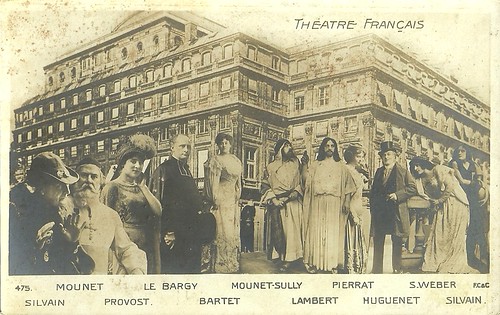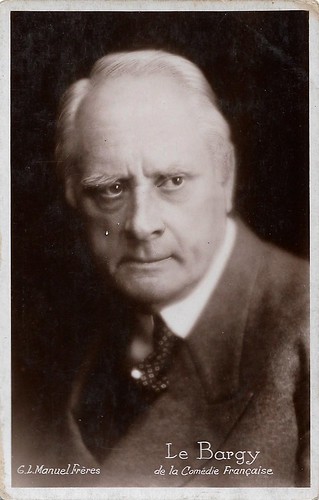
French postcard in the series Nos acteurs célèbres.

French postcard in the series Nos artistes dans leurs expressions by Paris sur Scène, no. 1020.

French postcard in the series Nos Artistes dans Leur Loge, no. 214. Photo: Comoedia.
Man of Fashion
Charles Gustave Auguste le Bargy was born in La Chapelle, France, in 1858. His talent both as a comedian and as a serious actor soon became evident.
He became a sociétaire (company member) of the Comedie-Française. His wife, Simone le Bargy née Benda, an accomplished actress, made her debut at the Gymnase in 1902, and in later years had great success in 'La Rafale' and other plays.
For years Le Bargy was an idol for the audiences of France's national playhouse. His chief successes were in such plays as 'Le Duel', 'L'Enigme', and Henri Laveden's play 'Le Marquis de Priola'. The title role in the latter play and his aristocratic bearing gave him his nickname the 'Marquis de Priola'.
According to a report in the New York Times in 1910, he was one of the leaders of 'the men of Fashion' of Paris. His perfect taste in dress, his exquisite cravats and his divorce from Simone gained him undying boulevard fame.
In 1910, he had a quarrel with Jules Claretie, the administrator of the Comedie-Française, and Le Bargy ceased to be a sociétaire.

French postcard. Charles Le Bargy as the Marquis de Trémouille in the play 'Patrie!' (1869) by Victorien Sardou, performed in 1901 in Paris at the Comédie Française.

French postcard. Charles Le Bargy as the Marquis de Tremouille in the play Patrie! (1901) by Sardou.

French postcard by F.C. & Cie., Paris, no. 475. This card shows a 1920s photomontage of the actors of the Comédie Française, partly dressed in the costumes of their most famous plays. In the back, the Théàtre Français, home of the Comédie. From left to right: (Eugène) Silvain/ Sylvain, Paul Mounet, Jeanne Provost, Charles Le Bargy, Julia Bartet, Jean Mounet-Sully, Albert Lambert, Pierrat, Huguenet, Ségond-Weber, Louise Silvain. Almost all of these actors also had a film career, either in the Film d'art films of the early 1910s or (also) at later stages.
A new kind of cinema
Charles Le Bargy's cinema debut was as the perfidious King Henri III in the short silent film L'Assassinat du Duc de Guise/The Assassination of the Duke of Guise (1908). King Henri III lures the Duke of Guise (Albert Lambert), who has become too powerful, to his castle in Blois and has him murdered brutally.
The film was directed by Charles Le Bargy himself, together with André Calmettes. It was a production by the new Societé du Film d'Art (1907), which introduced a new kind of cinema: historical films with stage actors based on either historical events or famous stage plays and novels.
The prominent designer Emile Bertin designed the sets, and the famous composer Camille Saint-Saëns wrote a score, especially for the film, a new concept at the time. The script was explicitly written for the cinema by Henri Lavedan, though the setting and costumes were quite theatrical.
On 17 November 1908, L'Assassinat du Duc de Guise had its premiere in Paris at the Theatre Charras, near the Paris Opera. For the first time, the press reported widely about a film. Contrary to historical myths, the acting of Charles Le Bargy and the other actors in L'Assassinat du Duc de Guise was quite restrained in comparison with previous films. It was such a success, that other companies and countries wanted to have their own film d'art subsidiaries, such as Pathé's SCAGL, and Eclair's ACAD.
Film company Pathé Frères, who distributed L'Assassinat du Duc de Guise abroad, opened a separate company in Italy, Film d'Arte Italiana (1909), producing historical and theatrical films. Francesca Bertini, one of the Italian divas, would start her career here. In the US, Biograph and Vitagraph took good notice of Le Bargy's film. D.W. Griffith must have learned of the restrained action, the coherent narrative and the relatively complex psychology of the film.

French minicard (collector's card) in the collection Félix Potin, series 1 (c. 1900). Photo: Boyer, Paris.

French postcard by PMM. Photo: Boyer, Paris.
Tosca
Charles Le Bargy played Baron Scarpia in the second film version of the Victorien Sardou play 'Tosca', La Tosca (André Calmettes, Charles Le Bargy, 1909) featuring Cécile Sorel as La Tosca. Though Le Bargy then left Film d'Art, his influence remained so crucial that the studio kept filming in the studio instead of on location.
After the initial success, subsequent Film d'Art films such as La Tosca were far less popular and Film d'Art was in a crisis. In 1911, a new board by Charles Delac and Louis Nalpas took over and revived the company, producing such hits as La Dame aux camélias/Camille (1911) with Sarah Bernhardt and a 4000-meter version of Les Trois Mousquetaires/The Three Musketeers (Henri Pouctal, 1913).
Le Bargy appeared in some more silent films like L'appel du sang/The Call of the Blood (Louis Mercanton, 1919) with Ivor Novello, the Italian production Il colonnello Chabert/Out of the Depths (Carmine Gallone, 1920) and Madame Récamier (Tony Lekain, Gaston Ravel, 1928) starring Marie Bell.
His last film appearance was in the sound production Le rêve/The Dream (Jacques de Baroncelli, 1931) based on a novel by Émile Zola.
Charles Le Bargy died in Nice, France, in 1938. His son was the actor Jean Debucourt.

French postcard by Editions Filma in the series Les Vedettes du Cinéma, no. 23. Photo: Films Mercanton.

French postcard. Photo: G.L. Manuel Frères. Caption: Le Bargy de la Comédie Française.
L'Assassinat du duc de Guise/The Assassination of the Duke of Guise (1908). Source: Ruey Yen (YouTube).
Sources: Richard Abel (Encyclopedia of Early Cinema), New York Times, Wikipedia and IMDb.
This post was last updated on 3 May 2023.
Fascinating, as always! I don't know how you do it. I love the picture of Sarah Bernhardt. I was also very interested to read about Pat and Patachon. Wonderful!
ReplyDeleteEach image is always so evocative of the period. I suppose that's often my favorite thing in period movies - the costuming and hair and makeup. Thanks, as always, for wonderful pictures and in-dpth info.
ReplyDeleteWonderful postcards - what a handsome couple. I love your posts - especially since I've not heard of so many of the film stars - I heard it first here!
ReplyDeleteHowdy Bob
ReplyDeleteHappy PFF to you .
I got lost in reading and forgot to scroll back up to comment.
There was so much to see today .
Well I must tell the truth I also read some of your older posts to get caught up:)
Than I wondered over to the side bar and clicked on a few things there !
Thank you so very much for all the time and work you put into each post.
I always enjoy coming by to visit your impressive way of sharing the unknown details .
Happy Trails
A very elegant man, and I love the picture of him as Henri III. The period just gets into my grandmother's time. I can remember her talking about Sarah Bernhardt and Ivor Novello.
ReplyDeleteHello PFF friends,
ReplyDeleteIt was good to visit your wonderful blogs and read your sweet comments. Thanks. Till next friday.
Bob